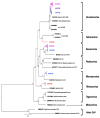Longitudinal Survey of Coronavirus Circulation and Diversity in Insectivorous Bat Colonies in Zimbabwe
- PMID: 35458511
- PMCID: PMC9031365
- DOI: 10.3390/v14040781
Longitudinal Survey of Coronavirus Circulation and Diversity in Insectivorous Bat Colonies in Zimbabwe
Abstract
Background: Studies have linked bats to outbreaks of viral diseases in human populations such as SARS-CoV-1 and MERS-CoV and the ongoing SARS-CoV-2 pandemic.
Methods: We carried out a longitudinal survey from August 2020 to July 2021 at two sites in Zimbabwe with bat-human interactions: Magweto cave and Chirundu farm. A total of 1732 and 1866 individual bat fecal samples were collected, respectively. Coronaviruses and bat species were amplified using PCR systems.
Results: Analysis of the coronavirus sequences revealed a high genetic diversity, and we identified different sub-viral groups in the Alphacoronavirus and Betacoronavirus genus. The established sub-viral groups fell within the described Alphacoronavirus sub-genera: Decacovirus, Duvinacovirus, Rhinacovirus, Setracovirus and Minunacovirus and for Betacoronavirus sub-genera: Sarbecoviruses, Merbecovirus and Hibecovirus. Our results showed an overall proportion for CoV positive PCR tests of 23.7% at Chirundu site and 16.5% and 38.9% at Magweto site for insectivorous bats and Macronycteris gigas, respectively.
Conclusions: The higher risk of bat coronavirus exposure for humans was found in December to March in relation to higher viral shedding peaks of coronaviruses in the parturition, lactation and weaning months of the bat populations at both sites. We also highlight the need to further document viral infectious risk in human/domestic animal populations surrounding bat habitats in Zimbabwe.
Keywords: Zimbabwe; bat coronavirus (Bt CoVs); genetic diversity; human–bat interaction; reproductive phenology.
Conflict of interest statement
We declare that we have no conflict of interest.
Figures





Similar articles
-
Longitudinal monitoring in Cambodia suggests higher circulation of alpha and betacoronaviruses in juvenile and immature bats of three species.Sci Rep. 2021 Dec 17;11(1):24145. doi: 10.1038/s41598-021-03169-z. Sci Rep. 2021. PMID: 34921180 Free PMC article.
-
Circulation of Alphacoronavirus, Betacoronavirus and Paramyxovirus in Hipposideros bat species in Zimbabwe.Infect Genet Evol. 2018 Mar;58:253-257. doi: 10.1016/j.meegid.2018.01.007. Epub 2018 Jan 10. Infect Genet Evol. 2018. PMID: 29331670 Free PMC article.
-
Bats and humans during the SARS-CoV-2 outbreak: The case of bat-coronaviruses from Mexico.Transbound Emerg Dis. 2021 May;68(3):987-992. doi: 10.1111/tbed.13751. Epub 2020 Aug 16. Transbound Emerg Dis. 2021. PMID: 32725795
-
[Etiology of epidemic outbreaks COVID-19 on Wuhan, Hubei province, Chinese People Republic associated with 2019-nCoV (Nidovirales, Coronaviridae, Coronavirinae, Betacoronavirus, Subgenus Sarbecovirus): lessons of SARS-CoV outbreak.].Vopr Virusol. 2020;65(1):6-15. doi: 10.36233/0507-4088-2020-65-1-6-15. Vopr Virusol. 2020. PMID: 32496715 Review. Russian.
-
[Source of the COVID-19 pandemic: ecology and genetics of coronaviruses (Betacoronavirus: Coronaviridae) SARS-CoV, SARS-CoV-2 (subgenus Sarbecovirus), and MERS-CoV (subgenus Merbecovirus).].Vopr Virusol. 2020;65(2):62-70. doi: 10.36233/0507-4088-2020-65-2-62-70. Vopr Virusol. 2020. PMID: 32515561 Review. Russian.
Cited by
-
Absence of Coronavirus RNA in Faecal Samples from Wild Primates in Gabon, Central Africa.Pathogens. 2023 Oct 23;12(10):1272. doi: 10.3390/pathogens12101272. Pathogens. 2023. PMID: 37887788 Free PMC article.
-
A comprehensive dataset of animal-associated sarbecoviruses.Sci Data. 2023 Oct 7;10(1):681. doi: 10.1038/s41597-023-02558-5. Sci Data. 2023. PMID: 37805633 Free PMC article.
-
Hibernating vesper bats are a weak source for biomonitoring of coronaviruses.One Health. 2024 Apr 23;18:100733. doi: 10.1016/j.onehlt.2024.100733. eCollection 2024 Jun. One Health. 2024. PMID: 38694618 Free PMC article.
-
Synchronized seasonal excretion of multiple coronaviruses coincides with high rates of coinfection in immature bats.Nat Commun. 2025 Jul 17;16(1):6579. doi: 10.1038/s41467-025-61521-7. Nat Commun. 2025. PMID: 40675980 Free PMC article.
-
Study of coronavirus diversity in wildlife in Northern Cambodia suggests continuous circulation of SARS-CoV-2-related viruses in bats.Sci Rep. 2025 Apr 12;15(1):12628. doi: 10.1038/s41598-025-92475-x. Sci Rep. 2025. PMID: 40221475 Free PMC article.
References
-
- ICTV Positive Sense RNA Viruses: Coronaviridae. 2020. [(accessed on 1 December 2021)]. VIRUS Taxon. Available online: https://talk.ictvonline.org/
Publication types
MeSH terms
LinkOut - more resources
Full Text Sources
Medical
Miscellaneous

